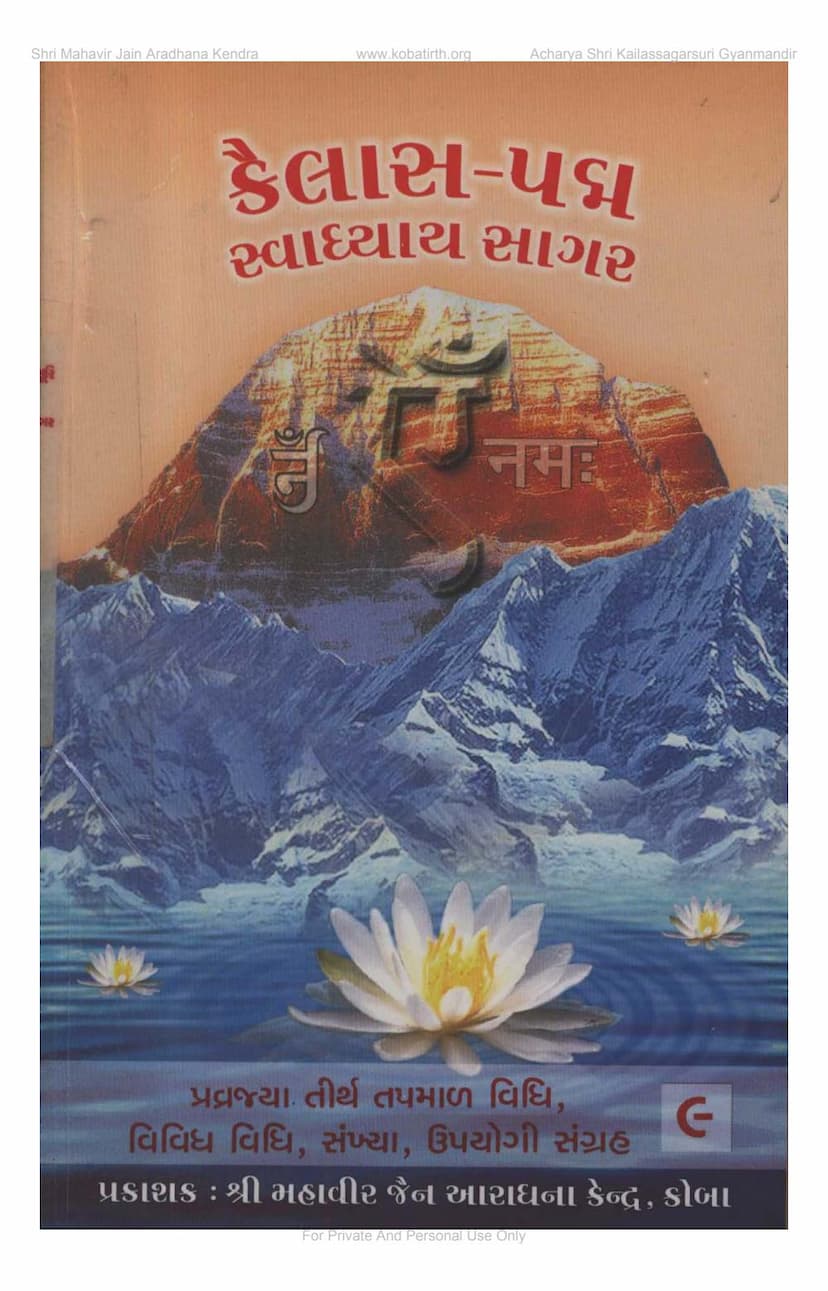Kailaspadma Swadhyayasagara Part 9
Added to library: September 2, 2025

Summary
Here's a comprehensive summary of the provided Jain text, "Kailaspadma Swadhyayasagara Part 9," based on the scanned pages:
Title: Kailaspadma Swadhyayasagara Part 9 (કૈલાસ-પદ્મ સ્વાધ્યાય સાગર ભાગ ૯)
Author: Padmaratnasagar (મુનિ પદ્મરત્નસાગર)
Publisher: Shri Mahavir Jain Aradhana Kendra, Koba (શ્રી મહાવીર જૈન આરાધના કેન્દ્ર, કોબા)
Catalog Link: https://jainqq.org/explore/008486/1
Overview:
This volume, "Kailaspadma Swadhyayasagara Part 9," is the ninth installment in a series dedicated to providing guidance and rituals related to Jain spiritual practices. The title itself, "Swadhyayasagara," translates to "Ocean of Self-Study," indicating the comprehensive and in-depth nature of the knowledge contained within the series. This particular part focuses on rituals, procedures, numerical classifications, and useful collections pertaining to initiation (Pravajya), vows (Vrat), austerities (Tap), and pilgrimage (Tirthmala).
Key Themes and Content:
The text serves as a practical guide for Jain ascetics and lay followers, detailing various procedures and knowledge for spiritual advancement. Based on the table of contents and scattered text snippets, the book covers:
- Rituals for Initiation (Pravajya Vrat-Tap-Tirthmala Vidhi): This is a central theme, outlining the step-by-step procedures for the initiation ceremony, likely for renunciation or taking on specific vows. It includes methods for both those undergoing a minor initiation and a more comprehensive one.
- Various Rituals (Vividh Vidhi): The book details numerous ritualistic procedures, including:
- Installation of Acharyas (Sthapanacharya Pratishtha Vidhi): Procedures for establishing and consecrating spiritual leaders.
- Mantras and their application (Mantravani Vidhi): This includes rituals involving specific mantras like the Navkar Mantra (Navkarvali Mantra), protective charms (Raksha Potli Mantra), and auspicious blessings (Vasakshep Mantra).
- Ceremonies for entering Chaturmas (Chaturmas Pravesh Vageire Prasang par Nagar Pravesh ni Vidhi): Rituals for the commencement of the Chaturmas period.
- Housewarming ceremonies (Makan Pravesh Vidhi): Procedures for sanctifying a new residence.
- Temple-related rituals: Such as the ceremony for hoisting a flag on the temple's anniversary (Derasar ni Varshganthhe-Dhwaja Chadhavvano Vidhi).
- Specific Vidyas (Enchantments/Knowledge Systems): Mention of "Vardhaman Vidya" and "Suri Mantra," indicating the use of specific mantras and mystical diagrams for various purposes.
- Numerical Classifications and Collections (Sankhya, Upyogi Sangrah): A significant portion of the book seems dedicated to classifying and enumerating various spiritual concepts, practices, and their associated numbers. This includes:
- Detailed numerical breakdowns of various categories of Jain practices, concepts, and classifications (e.g., Sankhya 1 to Sankhya 1824120). These classifications likely relate to the stages of spiritual practice, types of karma, classifications of souls, categories of Jain scriptures, and various ritualistic elements.
- Lists of auspicious and inauspicious times and actions.
- Yantras (Mystical Diagrams): Mention of specific Yantras for practices like "Laghu Yogodvahan Yantra" and "Upadhan Tapadi Yantra."
- Pattavali (Lineage of Spiritual Teachers): A historical lineage of spiritual leaders, starting from Lord Mahavir.
- Guidance for Study and Practice:
- Agam Vachan Vidhi: Procedures for studying Jain scriptures.
- General principles and suggestions for chanting (Jaap karta Suchan and Aavarto): This section likely provides guidelines on posture, focus, and the number of repetitions for meditative chanting.
- Principles for studying Vidyas (Vidya Abhyas mate): Guidance on the best times and teachers for learning spiritual knowledge systems.
- Guidelines for using new items: Including new utensils (Navin Patra Vaparva mate) and new clothes (Navin Vastra Dharan karva mate).
- Auspicious Omens (Prayan ma Shreshth Shukun): Lists of good omens to be observed during travel or significant undertakings.
- Sanskrit and Prakrit Verses and Mantras: The text is replete with verses from Jain scriptures, mantras, and their associated rituals, often presented in Sanskrit and Prakrit.
Purpose and Significance:
This book is a valuable resource for the Jain community, especially for those involved in spiritual practice and ritualistic leadership. It aims to:
- Preserve and disseminate Jain rituals and practices: Providing clear instructions for complex ceremonies.
- Educate followers on spiritual knowledge: Offering insights into various numerical classifications, concepts, and historical lineages.
- Facilitate spiritual growth: Guiding individuals in their journey of self-study and adherence to Jain principles.
- Serve as a reference manual: For monks, nuns, and devout lay people for performing rituals and understanding Jain lore.
The publication is presented with gratitude and blessings from revered Jain Acharyas, highlighting the importance of spiritual learning and adherence to the teachings of the Tirthankaras. The dedication page mentions the occasion of the 52nd year of renunciation and the 72nd year of a revered guru, emphasizing the lineage and continuation of Jain tradition.